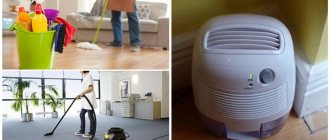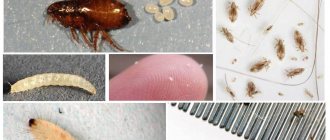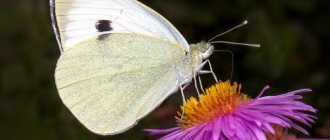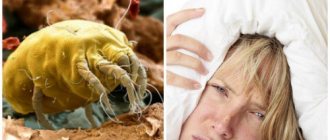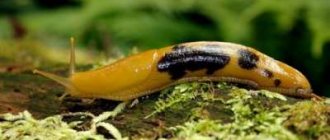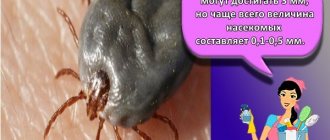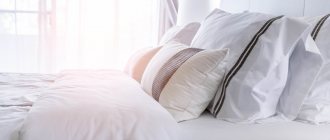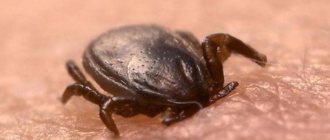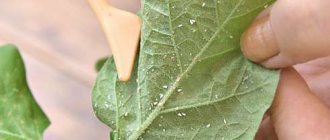Dust mites, or carpet mites, are found in every apartment. These microscopic arthropods inhabit every carpet, blanket and pillow. They are found wherever there is dust, where a person lives, especially where he spends a lot of time and where flakes of his dead skin accumulate.
In itself, the proximity of a person and a dust mite does not pose any threats. However, under favorable conditions for the tick, its population can greatly increase. This also happens because the residents of the house do not comply with sanitary standards and rarely clean the apartment. In this case, the concentration of mites can reach 10,000 individuals per gram of dust.
Naturally, such a large number of insects produces a large amount of waste. It is the tick excrement that contains enzymes that can cause allergies. Allergies can especially affect the health of people with asthma and low immunity.
It is noted that up to 15 percent of the mass of feather pillows can be mite waste. This happens when home owners rarely carry out procedures to clean the house from dirt.
If you experience the following symptoms: dizziness, increased fatigue. If you experience frequent choking or a rash on your skin, it may be a sign that there are too many dust mites in your home. In this case, you will need to carry out a number of procedures that will help you get rid of insects and destroy house dust mites. Protect yourself and your loved ones from allergies!
What it is?
Definition
House ticks belong to the type of sinatropic mites, that is, they are closely related to humans and their homes, just like mice, cockroaches, bed bugs, etc. At this time, microbiologists have established that there are more than 150 species of these parasites . And more than 10 species can cause an allergic reaction in humans.
The size of these parasites is so small that it is impossible to see them without a microscope. But their number in our house is huge - up to a thousand in just 1 g of dust, and up to hundreds of millions on our bed.
The peculiarity of dust mites is that they cause allergies. Feels good in carpets, feather pillows, mattresses, sofas, bed linen, etc.
All this is located approximately 1 meter from the floor and, when it enters the body, it provokes allergies. If the concentration of dust mites exceeds the norm, asthma may occur.
The dust mite feeds on dead skin particles , which a person loses, as is known, every day, in the amount of 1.5 - 2 g.
The mites themselves leave behind traces - feces, which destroy human skin and are very dangerous because they cause severe allergies.
REFERENCE! Each tick releases up to 20 fecal pellets per day. That is, only 1 mite produces 200% more waste than its own weight!
German scientists from the University of Munich have long proven that in children who live in villages and suburbs, allergies are much less common due to early contact with pets than in residents of cities and large cities who live in relatively sterile conditions, far from living things. nature.
How do they look?
Dust mites belong to the family of arachnids of the arthropod class. Very small, no more than 0.5 mm in size. Not noticeable to the naked eye, they are dangerous to humans and cause asthma and other allergic reactions.
Dust parasites live only 2-3 months, but how much harm and real danger each of them brings! The female can lay 50–60 eggs at a time.
Dust mites thrive in damp rooms, in apartments with high humidity and musty air. They like to live at temperatures from 19 to 25 °C, with air humidity above 55 - 60%.
What dust mites look like and how to recognize them is discussed here.
Existing types
Dust mites are conventionally divided into three types:
- Pyroglyphid (dermatophagoid: for example d farinae and d pteronyssinus) and some representatives of granary mites that appear from house dust.
- Predators are mites that feed on pyroglyphid mites.
- Random ticks brought in from outside and not reproducing in the apartment.
What harm do they do to humans?
It is known that a dust mite bite cannot be found on human skin. This is explained by the fact that they are too small, and therefore simply incapable of this. On the other hand, they constantly feed, and this leads to the fact that they secrete the products of their vital activity. This thesis refers to fecal matter or feces in which special digestive enzymes-proteins are present. These substances help destroy human skin cells so that mites can feed, and then they are also released in the feces of individuals.
Together with dust, a person inhales them (the size of one such feces is on average about 30 microns). Once on the mucous membranes or skin of a person, these substances begin to dissolve and dissolve the cells of the human body. As a result, the immune system begins to react to them as if they were an allergen, provoking a severe allergic reaction, especially if a person is genetically predisposed to it.
Laboratory allergy tests test for dust. If dust mites are present, a person may react to the P1 antigen, causing the corresponding symptoms.
Habitat
The favorite places for dust mites to appear and accumulate are any “deposits” of dust. These can be bookshelves, old books, children's soft toys, baseboards, carpets, old shoes and other “dust collectors”.
Dust mites also love wool blankets, carpets, upholstery, carpeting and other fleecy surfaces. Pillows are generally a “nest” of dust mites.
It is almost impossible to get rid of parasites here; it is better to replace the pillow, especially with feather or down filling.
Today, more than 150 species of mites live in the dust of apartments and houses.
REFERENCE! There are from 100 to 1000 mites per 1 g of dust; the population varies depending on the time of year. The end of summer - the beginning of autumn is the peak of the number of dust mites in houses and apartments.
Why are they dangerous?
For children
This tick is especially dangerous for a child. The child, as you know, is small in stature and is always closer to the floor. And the lower, the more dust, the greater the accumulation of parasites. The more often respiratory dysfunction is observed in children.
IMPORTANT! All possible allergic manifestations, including exacerbation of bronchitis, the appearance of signs of bronchial asthma, require consultation with an allergist, immunologist and other specialized specialists.
According to statistics, 70% of children with bronchial asthma are allergic to dust mites , which live in blankets and carpets with animal hair, as well as in books, notebooks and furniture. With tick-borne bronchial asthma, exacerbations occur most often in autumn and spring.
Sometimes dust allergens provoke a disease in children such as atopic dermatitis - an allergic inflammation of the skin, both on the face and throughout the body.
In children, it begins at an early age with food allergies, gradually progresses to atopic dermatitis, and then progresses to allergic rhinitis and bronchial asthma. This, in turn, already entails certain treatment.
For adults
Dust mites themselves, dust, and mite waste products are very small particles that enter the respiratory tract and cause allergic reactions.
What concentration of dust mite accumulation is dangerous?
- Up to 100 mites per gram of dust - this concentration is safe for humans.
- 500 insects per gram - risk of asthmatic attack.
- from 1000 to 2000 – the risk of allergies and chronic runny nose, conjunctivitis in people predisposed to this.
Dust mites can cause various types of allergies and illnesses:
- bronchial asthma;
- acarodermatitis - due to dust mite bites;
- allergic rhinitis;
- respiratory allergies - due to inhalation of mites;
- atopic dermatitis;
- conjunctivitis and other mucosal diseases.
The main cause of all reactions is an allergy to dust mites, increased sensitivity to mite allergens.
It is important to realize: dust mite allergy is a life-threatening phenomenon .
If you find an allergic reaction to apartment dust mites, immediately contact an allergist to determine the presence of these antibodies in your blood.
For pets
Dust mites do not pose a physical danger to our pets . They do not bite, do not damage the skin, and do not crawl into the ears and nose. They feed only on dead skin cells - the epidermis.
The fur of pets is a habitat for dust mites. In order to prevent dust mites from spreading to the fur of animals, they need to be bathed with special shampoos, their rugs washed, and their “resting places” treated.
After a walk, be sure to wash your paws and brush your favorite animals often. It is advisable to do this not on the carpet or on the sofa, but better in the bathroom, in the hallway, in a place where you can wash it all.
Signs of bed mites in your home
The most reliable method for determining these parasites in bed is to conduct laboratory tests. But when not everyone can use this method, it is easier to determine their presence by the person’s condition and the symptoms that appear:
- Lumpy rashes on the skin without bite marks;
- Possible (extremely rare) increase in temperature for no apparent reason;
- Sneezing without cold symptoms;
- Problems with respiratory function, wheezing;
- Inflammation of the mucous membranes in the eyes and nose;
- Rhinitis.
Children whose immune systems overreact to irritants are the first to suffer from the parasite. Moreover, it is skin reactions that appear first. But the bed tick bite itself cannot be detected on the skin due to the miniature size of the individuals.
Often, such symptoms can be attributed to other conditions - from dermatosis to diaper dermatitis and are not at all associated with the presence of a pest. But then the condition will regularly make itself felt, since it was not possible to get rid of the bed mite as the cause of the condition.
To suspect the presence of bed mites in a room, the easiest way is to examine your household and analyze the so-called sudden “allergies and colds.” Their significant increase should signal that invisible neighbors have settled in the home, and they should be dealt with as soon as possible.
What are they afraid of?
Dust mites are afraid of:
- direct sun;
- frosty air;
- wind;
- hot iron;
- any heat treatment, etc.
Most ticks live in the bed, so it is advisable to dry all bedding and ventilate it in the sun or in the cold, depending on the time of year.
Once a month, it is advisable to wash the floors with a salt solution : 300g per small bucket. When wiping dust, it is better to use a special dust removal liquid. After washing, it is better to iron the bed linen.
Cost of exterminating dust mites:
| Number of rooms | Cold fog | Cold Mist and Barrier Protection | Hot fog and barrier protection | Comprehensive treatment and barrier protection |
| 1 room apartment | 1800 rub. | 2700 rub. | 4500 rub. | 6200 rub. |
| 2 room apartment | 2000 rub | 3100 rub. | 4700 rub. | 6600 rub. |
| 3 room apartment | 2300 rub. | 3300 rub. | 4900 rub. | 6900 rub. |
| 4 room apartment | 2600 rub. | 3500 rub. | 5100 rub. | 7200 rub. |
| Common areas + kitchen | 1500 rub. | 2000 rub | 3000 rub | 4000 rub |
| *PPE - Personal protective equipment (gas mask, suit, gloves) for only 1,500 rubles. This kit is available for rent during processing. *The guarantee is provided when the entire apartment is processed. | ||||
Request a call back
How to withdraw?
BE CAREFUL! The more dust there is in the house, the more dust mites there are.
House dust mites always live in bed , since the habitat they need is located there - both humidity and temperature are maintained by the person himself.
- It is better to replace feather pillows with pillows with synthetic filling - latex, eco-fiber or bamboo fiber filling. All pillows with natural filling contain potential danger.
- Regularly carry out wet cleaning of the house.
- Wash floors with disinfectants.
- Be sure to throw away all collected debris from the vacuum cleaner.
- In winter, after washing, it is advisable to “freeze” the bed linen by hanging it outside, loggia, or balcony.
- In the summer heat, be sure to take pillows, blankets and mattresses outside into direct sunlight. Dust mites are afraid of heat; it is advisable to heat the laundry.
- Modern vacuum cleaners, thanks to their high power and excellent filtration, cope well with house dust mites.
- It is recommended to wash bed linen only in hot water, 70 - 80 degrees.
- Mattresses and pillows are the most “favorite” habitat for dust mites; change them every 7 years.
- Synthetic pillows filled with synthetic padding are washable.
- Regularly wipe off dust with a damp cloth or wash children's toys, even if they are just standing on the shelves in the nursery.
- Dishes that are very rarely used are always stored in the walls and sideboards, collecting dust. It is recommended to wash it with hot water from time to time or treat it with boiling water if it is glass or crystal.
- Bookshelves and bookcases should be wet cleaned regularly, at least once a week.
- Be sure to wash curtains and curtains at least once a month - they accumulate a lot of dust.
- The apartment should have as few carpets as possible, especially those that cover the entire floor.
- Carpet is especially dangerous. The surface must be hygienic: parquet, linoleum - something that can be wet cleaned.
RECOMMENDATION! The most effective remedy for dust mites today is the Fresh Air air purifier. After a day of operation of the air purifier, more than 50% of this pest dies.
You can completely get rid of dust mites in three days .
The effectiveness of modern air purifier technologies has been proven by laboratory studies by German and American scientists.
Preventing the reappearance of parasites
The most important and simple rule in the fight against dust mites is cleanliness.
- We wash the floors well at least once a week.
- We vacuum 2 – 3 times a week. It is advisable to use vacuum cleaners with an Aqua filter so that parasites do not spread throughout the apartment, flying out from the back of the vacuum cleaner.
- You need to vacuum not only carpets and floor coverings, but also chairs, beds, and upholstered furniture.
- Clean your closets well of old fur hats, coats, fur coats, unnecessary clothes and shoes. This is all an accumulation of dust, which means a “nursery” for dust mites. The closets should be spacious and clean.
- You need to wipe all shelves and cabinets, computer desk, notebooks, books with a damp, clean cloth.
- Treat lacquered furniture with polish.
- Bed linen should be changed every week, washed in hot water.
- It is necessary to store clean laundry in a dry place, as a humid environment promotes the appearance of dust mites.
- Featherbeds, feather and down pillows, if you cannot throw them away, then have them cleaned on time, at least 2 times a year. There the feathers are washed, treated with special solutions, and sewn into new pillowcases. This prevention will save you from parasites.
- Use dust mite repellents. Such preparations are sold for spraying in the room (aerosol) and for adding to the washing machine.
But the best recipe for defeating invisible tenants - dust mites - is still regularly cleaning your home and observing the rules of personal hygiene. It is necessary to arrange your apartment so that household dust does not harm our health.
Simple rules that will help fight dust mites in this video:
Ways to fight
The consequences of developing an allergy to dust mite waste products can be dealt with by desensitization therapy, including hormonal or antihistamine drugs. But in order not to have to sit on medications for the rest of your life, it is also necessary to begin a widespread fight against dust:
- Heavy blankets, feather beds, mattresses, and pillows should be dry cleaned once a season;
- Items must be ironed while wet on both sides;
- Using only a vacuum cleaner is not enough, and therefore wet cleaning is carried out daily;
- Bedding should be washed once a week;
- It is better to get rid of pile carpets and use homespun or wicker ones instead;
- When choosing furniture, it is better to refuse soft models of sofas, armchairs, and so on;
- It is also worth giving up draping windows with woven materials and purchasing blinds, which are much easier to maintain;
- It is better to keep air humidity within 40%, but not higher;
- The room is ventilated daily;
- Bedding should ideally be replaced with padding polyester or other artificial materials;
- Pets should be groomed regularly (including brushing and washing).
Since dust mites especially love human habitats with a high content of dust and particles of skin, fur, and hair, the first step is to carry out general cleaning. It is necessary to eliminate all places where dust, wool and other debris accumulate, and also look through old cabinets. It is possible that some things have long required airing in the fresh air. The methods of controlling dust pests do not end there.
To make cleaned surfaces unsuitable for further colonization by dust mites, you should wipe them with a special solution. In folk recipes, there is a remedy that many people use at home: add ¼ cup of any liquid soap to 1 liter of water and, after completely mixing, add ½ cup of ammonia. This solution can be wiped over surfaces such as floors, furniture, or added to water when washing.
It is important to realize that only treating bed linen and floors will not give the required results. You need to get rid of dust mites in a comprehensive manner. That is, it is necessary to influence furniture, clothes, soft toys, an animal’s bed, and so on. All dust accumulation areas are treated - from the top of cabinets to baseboards. At the same time, it is necessary to act comprehensively and on all rooms. At the same time, you need to inspect the contents of the cabinets, especially those that are opened no more than once a season - sideboards, pantries, and so on. Dust mites live in them in large numbers, especially if things are folded without being washed.
It is better to get rid of dust mites before serious consequences develop in the form of asthma and its attacks, including anaphylaxis.
